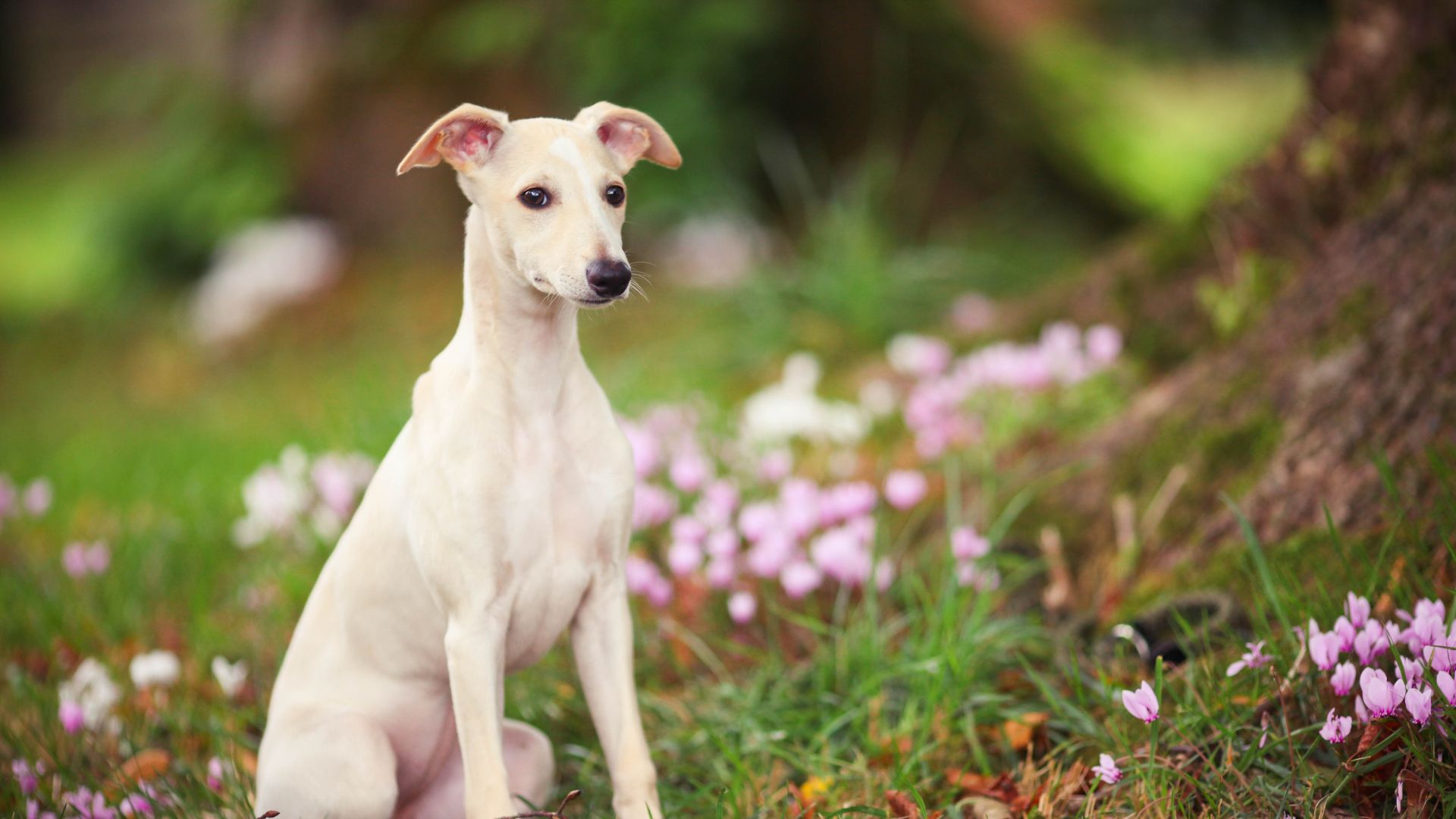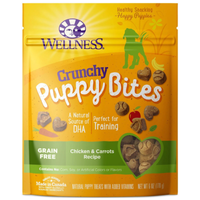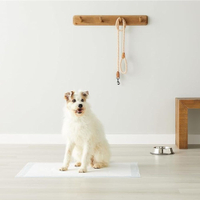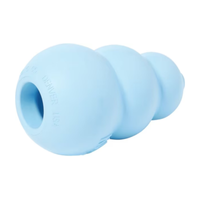Taking a puppy home for the first time
Everything you need to know about bringing home a puppy to be a part of your family!

Are you taking a puppy home for the first time? Congratulations! Welcoming a canine companion into your home can feel both exciting and a little overwhelming. As much as we wish it were as simple as stocking up on puppy food, a comfortable bed and a few toys, the reality is that there are lots of things you'll need to be aware of (and prepare for) once your little one joins your family.
Making the transition from spending all their time with their mom and littermates to being thrust into a new environment with human strangers can be a stressful experience for even the most resilient of puppies. But, the good news is, with a little bit of advance planning, you can help make the transition a whole lot easier for them.
Because there's so much to take in from how to bath a puppy to how to get a puppy to sleep through the night, so we’ve compiled a quick guide of things to remember as your puppy grows and develops. Every puppy is different, and your puppy may not follow this exact timeline. However, these are great things to know as your puppy ages, so you’ll be prepared each step of the way!
Before your puppy is eight weeks old
At this age, your puppy should still be with his mother and littermates. This is a critical period of learning for young puppies where they develop social skills by interacting with their mother and siblings. For good mental and behavioral development, it is essential that your puppy stay with his mother and siblings during this critical period. So while it may be tempting to pick up your new puppy early, it’s best to wait until at least eight weeks of age to allow your puppy more time to grow and develop! It’s important to learn about the signs of fading puppy syndrome.
In the meantime, this is a great time to start preparing for your new puppy’s arrival and to ensure that you have all the essentials your puppy is going to need. Let's take a look at the most important things you'll want to consider:
1. How to choose dog food and treats for a puppy
Let’s face it, there are a lot of brands out there claiming to have the best puppy food, so if you're feeling overwhelmed by the sheer number of choices lining the grocery store shelves, rest assured you're not alone. But, the good news is, with a little bit of background knowledge you can ensure you're feeding your little one the right fuel to help them grow up big and strong.
When it comes to choosing puppy food, it’s important to note that puppies have different needs than adult dogs, so they require a wet or dry food that has been formulated with the correct ratio of carbohydrates, fats and protein along with the right vitamins and minerals to ensure their brains and bodies develop in the way they should.
Look for a puppy food that is complete and balanced (it should state this on the label) and if possible, choose a puppy food that has been specifically designed to meet the needs of your puppy’s breed. If there isn’t a breed-specific formula available, it’s worth choosing one that is geared to either small dog breeds or large dog breeds, as they grow at different rates.
For the best puppy treats, select these based on what you plan to use them for. So, for example, if you're going to be undertaking leash training, you’ll want treats that are small and quick to eat so that you can keep up a high rate of reinforcement. For the crate, a longer-lasting treat that your puppy will take a little bit more time to eat can be ideal. Whatever you choose, make sure that treats make up no more than 10% of your puppy's daily calorie intake.
Wellness Natural Crunchy Puppy Bites Chicken & Carrots Recipe | Chewy
If you're training your pup, then you'll need some tasty treats to turn to and these crunchy chicken bites are a great choice. Our tester Michael noted that they're almost odorless, easy to store and his dogs enjoyed the taste.
Blue Buffalo Baby BLUE Natural Dry Food for Puppies | Amazon
Give your puppy the best start to life with this delicious and nutritious formula from Blue Buffalo. With DHA for brain and eye development and omega 3 and 6 fatty acids for skin and coat health, this wholesome kibble will help your little one grow up big and strong.
2. How to choose the best toy for a puppy
When it comes to the best puppy toys, you really are spoiled for choice with a wonderful array of options on the market that will provide your little one with a great physical and mental workout as they move through that all-important first year of their life.
We recommend you select several puppy toys to begin with, including comforting plush options that your little puppy can cuddle up with when they're experiencing stress or anxiety and some chew toys to see them through the painful puppy teething phase.
It’s also worth considering buying one of the best snuffle mats for dogs so that your puppy can forage for their food. This will let them engage in vital nose work while also providing a stimulating and enriching activity that will help develop and sharpen their young mind.
3. Consider puppy sleep aids and crates
Investing in one the best dog crates is a purchase well worth making. When choosing a crate for your puppy, make sure it is large enough for your puppy to stand up and turn around inside, but no larger. A crate that is too large will allow your puppy to soil in one area and sleep in another, which can be detrimental to the potty training process. If you do wish to purchase a larger crate for your puppy to grow into, consider using cardboard or pieces of solid plastic to section off a smaller area until your puppy is large enough to use the whole crate.
It’s also well worth having a few of the best puppy sleep aids on hand to help your little one get through the night. As this is the first time they've been away from their mother and littermates, it’s very common for puppies to feel scared in their new environment. A snuggly sleep aid can help mimic their mother’s warmth and help them to feel safe and secure in their crate.
New World Pet Products Folding Metal Dog Crate | Amazon
Keep your precious pooch safe and secure with this sturdy double-door metal crate from New World. Versatile and durable, it's ideal for crate training, sleeping or transporting your furkid from A to B.
4. Stock up on puppy potty training supplies
When it comes to how to potty train a puppy, our best advice is to make sure you establish a consistent routine and reward good behavior. You’ll also want bucket loads of patience, as while some puppies will literally have mastered potty training in just a few days or weeks, with others, it can take months.
In terms of supplies, puppy pads can be really useful to have, although they're best used only when you're not around to let your puppy outside to go to the toilet or the weather makes it impossible for them to leave the house. You’re really wanting to teach your puppy to only go to the toilet when you take them outside to do so rather than peeing in the house, but puppy pads are a suitable alternative to those times when being inside is the only option.
Believe it or not, you can also now purchase indoor dog potties and litter trays, just like you can with cats. So, that's another option that's worth considering if regular trips outdoors aren't doable.
Amazon Basics Puppy Pads | Amazon
These absorbent pads come in different sizes to ensure you get the right fit for your home and pup.
5. Puppy-proofing your home
This is also a good time to puppy-proof your home. Look for potential hazards at puppy level, including electrical cords, breakable items, or any particularly sentimental items that you do not want damaged. These should be put away out of reach. Consider using baby gates to section off areas of the house where you do not want the puppy to have access.
Puppy supply checklist
- Puppy food
- Puppy treats
- Dog crate
- Sleep aids
- Toys
- Puppy pads
- Baby gate
- Accessories – including food and water bowls, leash and harness, poop bags, bathtime supplies
Your puppy at 8-12 weeks old

At this age, your puppy can finally come home to meet his new family! Here are a few things worth bearing in mind during this crucial stage:
1. Introducing your new puppy to your home
Keep introductions to new family members brief and upbeat, and try not to overwhelm your new puppy by having him meet everyone at once. Instead, short interactions with each family member individually can help your puppy get to know everyone without becoming overwhelmed.
When introducing your new puppy to other pets, make sure to keep these introductions calm and very slow. It may be best to confine your puppy to a separate room at first so that the other pets in the household can get used to his presence, then gradually introduce them to each other.
2. Potty training your new puppy
Bringing home your new puppy means it’s also time to start potty training! For great tips on potty training puppies, check out Dr Sophia Yin’s book Perfect Puppy in 7 Days, which has an excellent step-by-step guide on how to potty training puppies. The most important thing to know is that you should never use punishment during potty training. Punishment causes fear and anxiety, which will only make potty training problems worse!
Punishing your puppy can also teach him that he should not urinate or defecate where you can see him, inadvertently teaching him to sneak off and do his business somewhere in the house when you aren’t watching! Instead of using punishment, focus on using positive reinforcement for dogs, which means rewarding good behavior with something positive like a tasty treat, praise, petting, or a special toy. By rewarding desirable behaviors, you’ll increase the likelihood that your puppy will want to repeat them again and again – and improve your puppy’s confidence in the process!
3. Tackling problematic puppy behaviors
Even with the most wonderful puppy in the world, it’s still likely that you're going to encounter a range of unwelcome puppy behaviors as your little one settles into their new home and learns what's expected of them.
While you may not experience all of these, some of the most common puppy behaviors include:
- Whining and barking while in their crate
- Urinating or defecating in their crate or around the house
- Inappropriate or destructive chewing behavior
- Mouthing, nipping and other inappropriate play behaviors (our guide to how to stop a puppy biting has lots of great advice for this specific problem)
- Jumping up on people
Thankfully, all of these issues can be stamped out early on with consistent training and lots of positive reinforcement when your puppy performs the ‘good’ behavior that's been asked of them.
4. The first night with your puppy
The first night your puppy sleeps in their new home can be challenging for both them and you. It's likely you won't get a lot of sleep in those first few days, so that’s worth preparing yourself for. Setting the tone of what's expected on that first night and ensuring you stick with this over the course of the next few weeks will ensure your puppy gets into a good bedtime routine.
One of the most important things that can help with this is to establish where your puppy is going to sleep and to make this their permanent spot. Create an evening ritual where you spend some time quiet time cuddling together before letting them out to go to the toilet. This calm time is very important as it signals to your puppy that play time is over and it’s time to settle down for the evening.
Make sure their crate has a cozy bed and blanket in it and a soft and comforting toy that they can snuggle up with. Crying is to be expected over the course of those first few evenings as your puppy gets used to being on their own. Once they know that every morning you come back and let them out of their crate, they’ll soon learn that a few hours away from you is nothing to be scared of. If the behavior does persist, however, our guide to how to stop a puppy crying in crate has plenty of helpful tips.
When it comes to toileting, you’ll need to get up several times during the night to let your puppy outside to relieve themselves. It can be helpful to take their age and add one to give you an indication of how often you'll need to do this. So, a two month old puppy can usually hold their bladder for three hours and a three month old puppy should manage four hours.
It’s important that when you let them out of their crate to go to the toilet that you don't play with them or cuddle them, as this may make it hard for them to settle down again. Instead, take them outside and return them to their crate as soon as they’ve been to the toilet, leaving the room again without any fuss.
5. Puppy vaccinations
At eight weeks of age, it’s also time to start your puppy’s vaccination series. The types of vaccinations your puppy receives and the timing of these vaccinations may vary depending on factors such as the disease prevalence in your local area and any veterinary care your puppy received while still with the breeder. Your vet will help you determine which puppy shots your dog needs, and the best time to administer these vaccinations.
First time home checklist
- Introduce people to your puppy calmly and slowly to avoid them becoming overwhelmed
- Use lots of positive reinforcement when potty training
- Tackle problem behaviors early and consistently and reinforce good behaviors with praise and treats
- Establish a bed time routine
- Speak with your vet about vaccinations
Your puppy at 12-16 weeks old

The three to four month mark is an important phase in your puppy’s physical and mental development and it's a great time to start getting them used to how to behave around other people and dogs, both inside and outside the home.
1. Socializing your puppy
As your puppy continues to grow and develop, it’s critically important that you socialize your puppy so that he becomes comfortable with new and unfamiliar people, dogs, and environments.
The goal of this process is for your puppy to experience these things in a positive, upbeat way. The experiences should be fun and rewarding for your puppy, so he learns that new things are fun and not scary. If at any point your puppy seems stressed, anxious, or overwhelmed, stop the socialization and remove your puppy from the situation until he has calmed down. You may need to consider using a different approach, a more gradual introduction, or a more rewarding environment and try the process again on a different day.
At this age, it’s also a good time to enrol your puppy in puppy classes. Puppy classes are important not just for obedience, but also for socializing with other puppies, and for teaching you and your puppy how to communicate effectively with each other. Look for a puppy class that requires all puppies to have begun their vaccination series, that keeps groups small, and that focuses on positive reinforcement training. This will ensure your puppy has a safe and fun experience during his classes.
2. Managing the teething phase
When a puppy is around three to four months old, their 28 baby teeth will begin to fall out to make room for the 42 adult teeth that will need to grow in. As you can probably imagine, this is a pretty painful time for your puppy but making sure you have plenty of the best teething toys for puppies on hand can help make this process a little less uncomfortable.
During this time, your puppy is going to want to chew on anything and everything that they can get their mouths on - including your clothes, shoes and furniture. Not only will having a range of chew toys on hand help soothe your little one's sore gums, it will also save your personal belongings from coming under attack.
This guide has some useful tips on how to stop a puppy chewing.
Kong Natural Teething Toy | Chewy
This durable teething toy is perfect for pups who will chew anything they can get their paws on. Our tester Sophie gave it to her dog, Wallie who also enjoyed playing hide and seek with it. She notes that it’s great for tiring out an energetic pup and is easy to clean in the dishwasher.
12-16 week checklist
- Start socializing your puppy and teaching them appropriate behavior around other people and animals, both inside and outside the home
- Invest in plenty of teething toys to see your puppy through the painful months when their adult teeth are growing in
Your puppy at 6 months old

You’re halfway through the first year of your puppy's life. Here’s what’s important at this stage:
1. Spaying or neutering your puppy
At 6 months of age, it is time to consider spaying or neutering your puppy. Spaying and neutering is important for the health of your dog and to prevent unwanted pregnancies from occurring. For large and giant breeds of dog, your vet may recommend waiting longer to spay or neuter as there is some evidence that waiting until the dog has reached musculoskeletal maturity (around 12-18 months of age for large and giant breeds) may prevent orthopedic problems in the future.
However, for small breed dogs, who reach musculoskeletal maturity much younger, spaying and neutering at six months does not seem to cause any ill-effect. Your veterinarian can help you determine the best time to spay or neuter your puppy depending on your puppy’s breed, expected adult size, and current health status.
2. Training an older puppy
This is also a good time to take stock of your puppy’s behavior and identify any behaviors that may be problematic. It is important to intervene on problem behaviors early so that they do not become larger problems later in your dog’s life. If you are encountering problem behaviors, working with your veterinarian, a positive reinforcement based dog trainer, or a veterinary behaviorist can help you modify that behavior before it becomes a larger problem. Remember that good dog training is a lifelong process of communication between you and your dog, and should always be based on positive reinforcement, never punishment.
6 month checklist
- Having a chat with your vet about getting your puppy spayed or neutered
- Consider further dog training if your puppy is continuing to engage in problematic behaviors
Your puppy at a year old

As you say goodbye to the puppy years and hello to adulthood, there are two final things you'll want to know about – transitioning your puppy over to adult dog food and ensuring they get their booster vaccinations. Let's take a look at both:
1. How to transition to adult dog food
At 1 year of age, your dog is now ready to transition from puppy food to an adult dog food. Check out our guide on how to choose dog food to help you find a good adult diet for your dog.
When transitioning to the new adult diet, make sure you do so gradually, as a quick change may upset your dog’s stomach. Start by mixing in 25% new food with 75% old food, then gradually build up to 100% new food over the course of a week or two. If your dog is known to have a sensitive stomach, you may want to make the transition period even longer.
2. Dog booster vaccinations
Around 1 year of age, your dog will be due for annual boosters of his vaccinations. Your veterinarian will help you determine which vaccinations your dog will need. For large and giant breed dogs, 12-18 months of age is the time to consider spaying or neutering your dog if you have not done so already.
Congratulations
Your dog is now considered an adult! While puppyhood may have ended too quickly, you still have many more adventures to explore with your dog as he continues to develop his social skills and learn new things. Enjoy this time with your dog and have fun.
Want to learn how to put a harness on a puppy, how to tire out a puppy or how to discipline a puppy? These guides have the answers.
PetsRadar Newsletter
Get the best advice, tips and top tech for your beloved Pets
Dr. Elizabeth Racine is a small animal general practice vet covering all things pet health and wellness. Her special interests include veterinary behavior, nutrition, and internal medicine.
As a freelance writer, Dr. Racine has written content for major companies in the industry such as the American Kennel Club, Merck Animal Health, Bayer PetBasics, Elanco, and CareCredit. In her free time, Dr. Racine enjoys playing trampoline dodgeball, hiking with her beagle Dasher, and spending time with her three mischievous cats.
- Bethany StoneFreelance Writer






